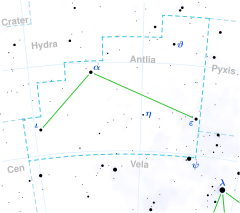Delta Antliae
| Observation data Epoch J2000 Equinox J2000 | |
|---|---|
| Constellation | Antlia |
| Right ascension | 10h 29m 35.37844s[1] |
| Declination | –30° 36′ 25.4413″[1] |
| Apparent magnitude (V) | +5.55[2] (5.58/9.65)[3] |
| Characteristics | |
| Spectral type | B9.5 V + F9 Ve[3] |
| U−B color index | –0.18[2] |
| B−V color index | –0.04[2] |
| Astrometry | |
| Radial velocity (Rv) | +14[4] km/s |
| Proper motion (μ) | RA: –32.512 ± 0.387[5] mas/yr Dec.: +0.918 ± 0.318[5] mas/yr |
| Parallax (π) | 7.1868 ± 0.2204 mas[5] |
| Distance | 450 ± 10 ly (139 ± 4 pc) |
| Absolute magnitude (MV) | –0.37[6] |
| Details | |
| δ Ant A | |
| Mass | 3.35 ± 0.15[6] M☉ |
| Luminosity | 200[6] L☉ |
| Temperature | 11,117[6] K |
| Rotational velocity (v sin i) | 27[7] km/s |
| Age | 214[6] Myr |
| Other designations | |
| Database references | |
| SIMBAD | data |
Delta Antliae (δ Ant, δ Antliae) is the Bayer designation for a binary star[6] system in the southern constellation of Antlia. The combined apparent visual magnitude of the system is +5.57,[2] allowing it to be viewed from the suburbs with the naked eye. Judging by the parallax shift of this system, it is located at a distance of 450 ± 10 light-years from Earth.[5] The system is reduced in magnitude by 0.03 due to extinction caused by intervening gas and dust.[3]
The primary component of the system has a stellar classification of B9.5 V, indicating that it is a B-type main sequence star. The companion is an F-type main sequence star with a classification of F9 Ve, where the 'e' indicates that there are emission lines in the spectrum. The two stars are separated by 11 arcseconds.[3]
Delta Antliae A, the brighter member of this system, has an estimated 3.4[6] times the mass of the Sun. It is radiating around 200[6] times as much luminosity as the Sun from its outer atmosphere at an effective temperature of 11,117 K.[6] At this heat, it shines with the characteristic blue-white hue of a B-type star.[8]
References[edit]
- ^ a b van Leeuwen, F. (November 2007), "Validation of the new Hipparcos reduction", Astronomy and Astrophysics, 474 (2): 653–664, arXiv:0708.1752, Bibcode:2007A&A...474..653V, doi:10.1051/0004-6361:20078357, S2CID 18759600.
- ^ a b c d Hurly, P. R. (1975), "Combined-light UBV Photometry of 103 Bright Southern Visual Doubles", Monthly Notes of the Astronomical Society of Southern Africa, 34: 7, Bibcode:1975MNSSA..34....7H.
- ^ a b c d Huélamo, N.; et al. (July 2000), "X-ray emission from Lindroos binary systems", Astronomy and Astrophysics, 359: 227–241, arXiv:astro-ph/0005348, Bibcode:2000A&A...359..227H.
- ^ Evans, D. S. (June 20–24, 1966), "The Revision of the General Catalogue of Radial Velocities", in Batten, Alan Henry; Heard, John Frederick (eds.), Determination of Radial Velocities and their Applications, Proceedings from IAU Symposium no. 30, vol. 30, University of Toronto: International Astronomical Union, p. 57, Bibcode:1967IAUS...30...57E.
- ^ a b c d Brown, A. G. A.; et al. (Gaia collaboration) (August 2018). "Gaia Data Release 2: Summary of the contents and survey properties". Astronomy & Astrophysics. 616. A1. arXiv:1804.09365. Bibcode:2018A&A...616A...1G. doi:10.1051/0004-6361/201833051. Gaia DR2 record for this source at VizieR.
- ^ a b c d e f g h i Hubrig, S.; et al. (June 2001), "Search for low-mass PMS companions around X-ray selected late B stars", Astronomy and Astrophysics, 372: 152–164, arXiv:astro-ph/0103201, Bibcode:2001A&A...372..152H, doi:10.1051/0004-6361:20010452, S2CID 17507782.
- ^ Royer, F.; Zorec, J.; Gómez, A. E. (February 2007), "Rotational velocities of A-type stars. III. Velocity distributions", Astronomy and Astrophysics, 463 (2): 671–682, arXiv:astro-ph/0610785, Bibcode:2007A&A...463..671R, doi:10.1051/0004-6361:20065224, S2CID 18475298.
- ^ "The Colour of Stars", Australia Telescope, Outreach and Education, Commonwealth Scientific and Industrial Research Organisation, December 21, 2004, archived from the original on 2012-03-18, retrieved 2012-01-16.

